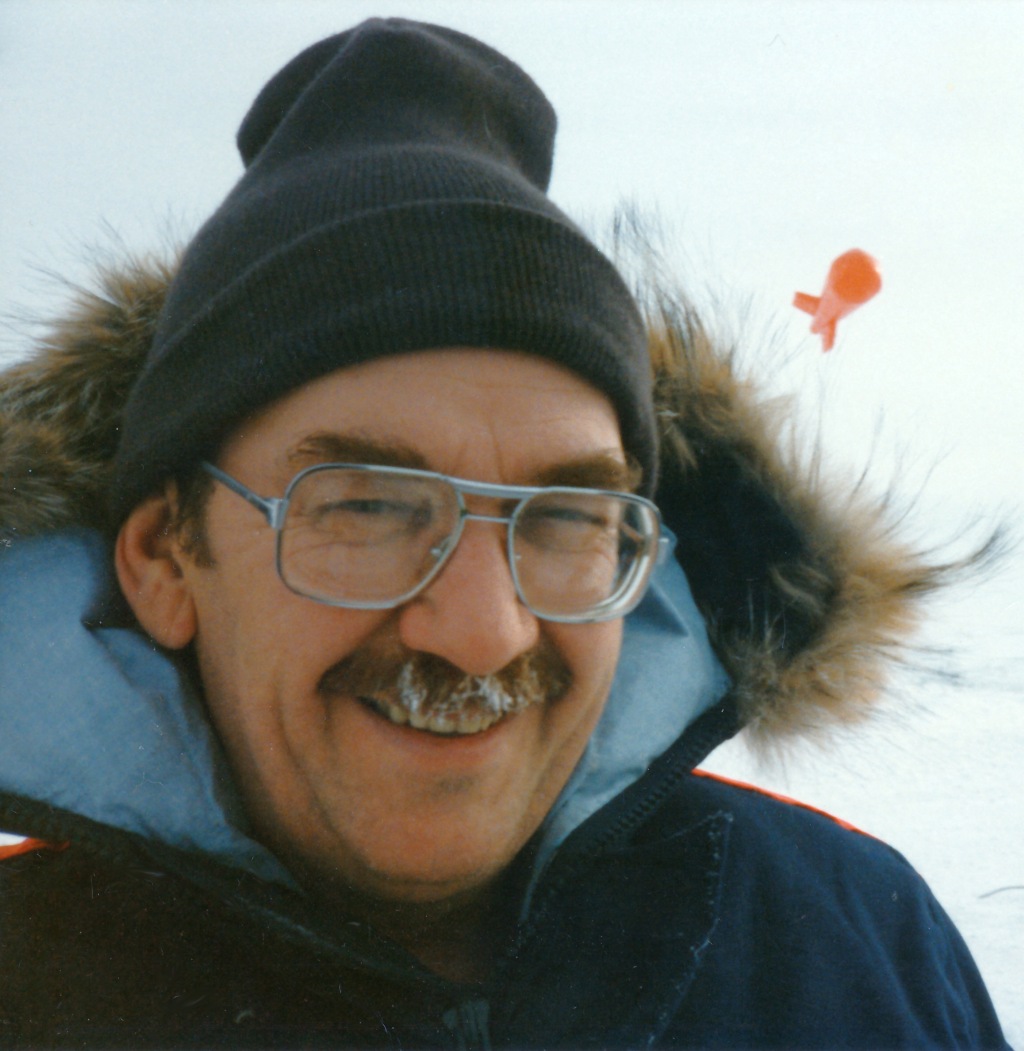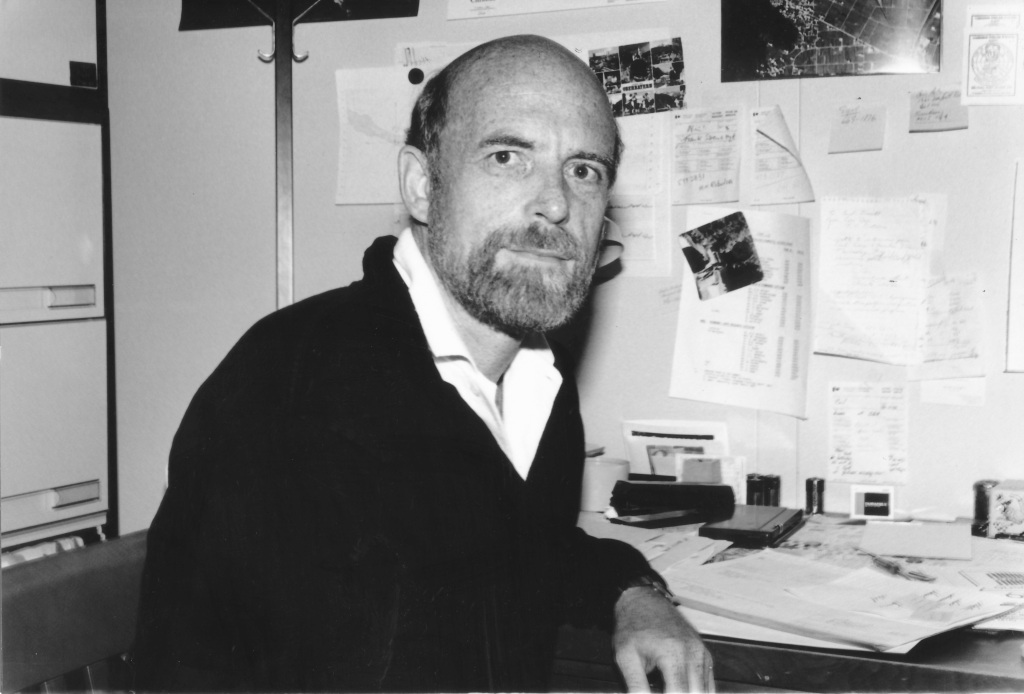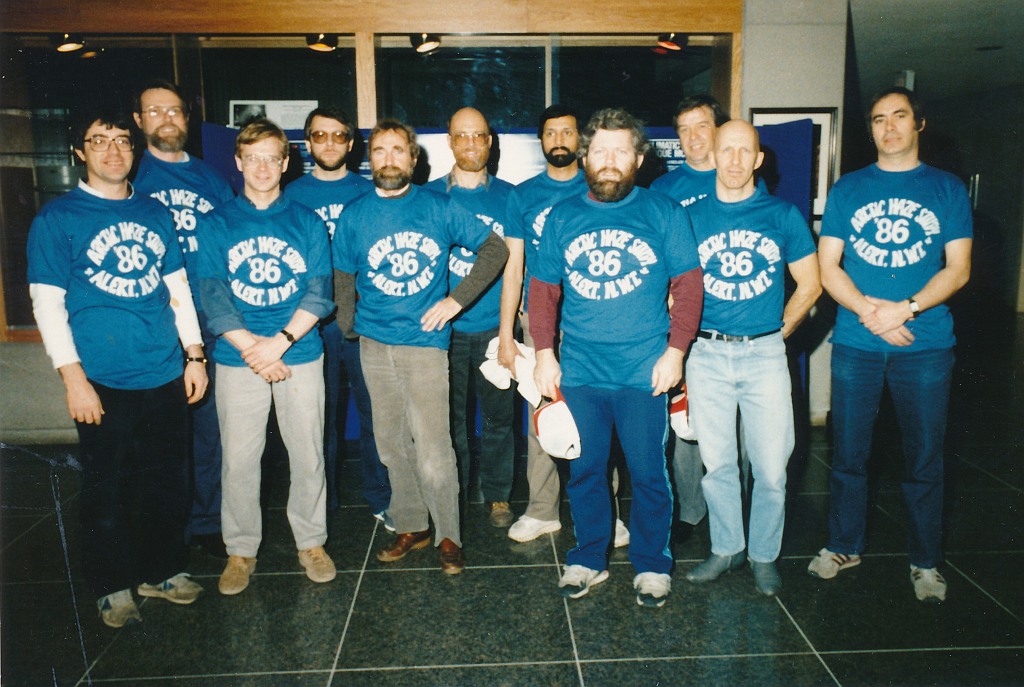Phil
Merilees Visits Arctic Haze *AGASP Project in Alert - 1986
*AGASP
- Arctic Gas and Aerosol Sampling ProjectScroll down for more photos.
 Phil Merilees Note by archivist: The small orange object above at right of Dr. Merilees' head in the photo is a tethered balloon used to carry various sensors which measure boundary layer parameters for the AGASP project (aka tethersonde). Colleagues familiar with the project confirmed this but, inexplicably, the tethersonde balloon was never mentioned in the Zephyr material - although it was visible as a tiny object in the original black and white photo. See below a related photo from 1987 Environment Week in Downsview, and of the entire Arctic Haze Study Group before departing for Alert |
Story reported in May / June
1986 edition of Zephyr
Getting there was half the challenge DG, AES Research Gasps at *AGASP Arctic Haze Is real, I have seen it and flown through it. Early In April 1986, I was invited by Neil Trivett, coordinator of the *AGASP Project to spend a few days at Canadian Forces Base Alert. This balmy spot Is only 500 miles from the North Pole and is also the site of the world's northernmost weather station operated by the Department of the Environment. Arctic Haze pollution occurs at Alert and the AGASP scientists are making pollutant measurements to find out where it comes from and how it is formed. Getting to Alert is just about as challenging as working there. It took about 8 hours of flying in a Canadian Forces Hercules from Trenton, sharing cargo space with 13 other intrepid passengers and tons of crates. While the vibration and noise prevented any conversation, sign language, sleep and considerate service by the crew made it bearable. In spite of the massive amount of Arctic clothing that I had to tote, I was not quite prepared for the 40 below (Celsius or Fahrenheit, take your pick) which greeted us at 4 pm. The people who met us were much warmer and it soon became obvious that the toughness in the Arctic conditions leads to friendly cooperation and closeness, a survival reaction. The next few days were spent visiting with different scientists, watching them work, discussing their findings, sharing their frustrations with experimental equipment that also seemed to object to the cold. I also visited the AES Upper Air Station and learned how these hard-working people provide for the quality weather data that so many people take for granted. A highlight of the trip was the opportunity to fly on the National Aeronautical Establishment's research aircraft the Twin Otter. AES and NAE have collaborated in atmospheric research for many years and the aircraft is a fine-tuned research tool. The research flights make measurements of the pollutants which form Arctic Haze. As we flew in the area of Alert, I could see exactly what the scientists and pilots were talking about. Layers of milky pollution extending up to about 1,200 feet. As we flew through it, AES instruments gobbled up samples of the pollutants and gave instant analyses of numbers of small pollution particles, numbers of large pollution particles, ozone and so on. While the digestion and distillation of this and the other data on the Arctic Haze will take much more time, it was clear that the scientists already know that the data is sensible and the experiment is going well. I was impressed with the interest and cooperation of all the base personnel in the conduct of AGASP, but especially so with the staff of the Alert Weather Station. Phil
Merilees, DG Atmospheric Research
|
Note the tethersonde on display in the
lobby; same type as seen, above, in Alert a year earlier.  Different view of tethersonde |
Neil Trivett from Zephyr 1987 "Mugs"
Collection Although Neil Trivett was not photographed by Zephyr on the occasion of Phil Merilees' visit to Alert he is shown here a year later, back in Downsview. See also 1989 * BAPMoN Project at Alert * BAPMoN - Background Air Pollution Monitoring See also: Lab Opening at Alert in 1986 See also: AGASP Project at Alert in 1986  A tethersonde being field tested |
Arctic Haze Study Group, Downsview - 1986
Group photo taken March 29, 1986 prior to month long stay at Alert NU to work on the Arctic Gas and Aerosol Sampling Program (AGASP)
Photo was published in the July / August 1986 edition of Zephyr and included the following text:|
Wearing special "Arctic Haze
Study" T-shirts, this group of AES scientists and technicians gathered
in the AES Downsview lobby before taking off for a month-long
stay at Alert NU working on the Arctic Gas and Aerosol Sampling
Program (AGASP).
|

absent: Doug EJ Worthy.
Return to Index